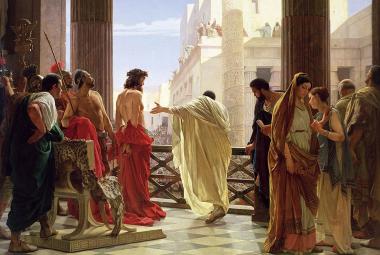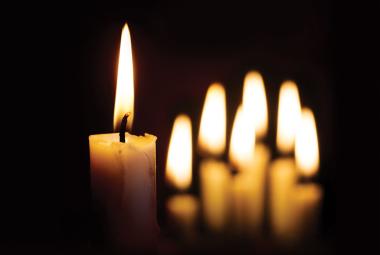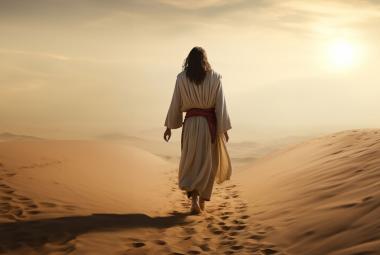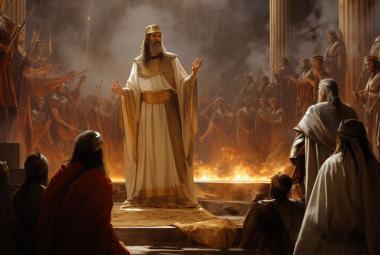The Fall Feasts of Israel take place during the first 15 days of Tishri on the Jewish calendar.1 This year, they all occur in the month of September.
The Seven Feasts of Moses
The Torah-the five books of Moses-detail seven feasts during the Jewish calendar year. Three feasts are in the spring, in the month of Nisan: Passover, the Feast of Unleavened Bread, and the Feast of First Fruits. Then, fifty days later there is the Feast of Weeks, Shavout , also known as Pentecost. There are three remaining feasts in the fall, in the month of Tishri
Everything in the Torah has a prophetic as well as historical significance and merits our careful attention. Jesus indicated this in Matthew 5:17:
Think not that I am come to destroy the law (the Torah), or the prophets: I am not come to destroy, but to fulfil.
Paul also emphasized it in Romans 15:4:
For whatsoever things were written aforetime were written for our learning...
The prophetic role of the feasts is also highlighted in Colossians 2:16-17:
Let no man therefore judge you in meat, or in drink, or in respect of a holyday, or of the new moon, or of the sabbath days which are a shadow of things to come.
The New Testament is in the Old Testament concealed; the Old Testament is in the New Testament revealed.
The 1st of Tishri: September 16th
The first of Tishri is Rosh Ha'Shana ("The Head of the Year" or the Jewish New Year). This day begins Israel's "civil" year (celebrated for two days; the second day was added by the rabbis around 500 B.C.).
However, when God instructed Moses to institute Passover, He also instructed him to make Nisan, the seventh month, "the beginning of months."2 Thus, the Jews also celebrate their religious new year, beginning at Nisan, in the spring.
It's interesting to notice that God established His "new beginning" of Planet Earth after the flood of Noah on the 17th day of the seventh month,3 which was Nisan. Jesus was crucified on Passover (the 14th of Nisan) and then spent three days in the grave, to be resurrected on the 17th.
Thus, God began our "new beginning" in Christ on the anniversary of the "new beginning" under Noah - some "coincidence!"
The first of Tishri is also known as Yom Teruah , the Feast of Trumpets.4
After a series of trumpet blasts, the climax of the celebration is the Teki'ah Gedolah, "the Great Blowing," which some associate with Paul's "last trump."5
If, indeed, Jesus was born on the 29th of September, 2 B.C., as some reckon, He would have been born on the Feast of Trumpets of that year.
(For further insights on Jesus' birthday, see our briefing package, The Christmas Story - What Really Happened.)
Yomim Noraim , the seven "Days of Affliction" begin immediately after the Feast of Trumpets and continues in anticipation of the Day of Atonement, Yom Kippur.
The 3rd of Tishri: September 18th
The Fast of Gedaliah occurs on the third of Tishri. While this is not a "Feast of Moses," it is observed by many Jews in memory of the slaying of Gedaliah, appointed by the Babylonians as governor of Judah after the capture of Jerusalem in 586 B.C.6
The 10th of Tishri: September 25th
The tenth of Tishri is Yom Kippur , The Day of Atonement. This day is a day of sin offerings and numerous other rituals as it is the most solemn of all of the observances in Israel.7
This was the day - the only day - in which the High Priest (he alone, and then only after elaborate ceremonial preparations) entered the Holy of Holies to sprinkle the blood of the sacrifices on the "Mercy Seat" of the Ark of the Covenant.
The offering of the Sin-Bearer also took place on Yom Kippur.8 This was the day that two goats were selected, one for an offering and one as the "scapegoat."
As many aspects of the feasts were prophetic, the scapegoat (as a symbol of grace) is also Messianic.9
The lottery box, used to select which goat was to serve in which capacity, has already been fashioned for service in the forthcoming Temple and may be seen during our visits to the Temple Institute in Jerusalem (see here for the complete itinerary of our upcoming trip to Israel this February).
This was also when the Water of Purification was prepared, using the Ashes of the Red Heifer.10 This background is essential if one is to really understand the significance of the water that Jesus turned into wine at Cana.11
Even the seven days preceding, the Days of Affliction, are an affliction of preparation, suggestive of the threshing floor, which is also a prophetic idiom ( Luke 3:16-17). Note the location of Ruth (a Gentile bride-to-be) during the threshing floor scene ( Ruth 3:8-9) - at Boaz's feet!
Since the loss of the Temple in A.D. 70 , the God-centered observances of the Torah have been tragically replaced by a man-centered, "good works" system of appeasement through prayer, charity, and penitence. But it appears that a return to the traditional ways is on the horizon with the preparations to rebuild the Temple in Jerusalem.12
The 15th of Tishri: September 30
Succoth, The Feast of Tabernacles (or Booths), begins on the 15th of Tishri.13 This lasts for eight days and is one of the three feasts which were compulsory for all Jewish males.14
It's fascinating to visit Israel at this time and observe them as they build their temporary "booths" in the traditional way, leaving deliberate gaps in the branches to view the stars at night and for the wind to blow through during the day. This is intended to remind them of the wilderness wanderings.
At the end of the eight days, they leave their temporary dwellings and return to their permanent homes.15
(This is one of the reasons some suspect that this feast, rather than the Feast of Trumpets, is suggestive of the Rapture of the Church. There also appears to be a hint of this by Peter, desiring to build "succoths" at the transfiguration.16)
This day, traditionally, is also the day on which Solomon dedicated the first Temple.
This feast also involved a daily processional to the Pool of Siloam to fetch water for the Temple. This ceremonial procession is the setting for the events of John 7, where Jesus offers them "living water."17 This procession involved four types of branches: the willow, the myrtle, the palm, and a citrus.18 The willow has no smell and no fruit; the myrtle has smell, but no fruit; the palm has no smell, but bears fruit; and, the citrus has both smell and bears fruit. Sounds reminiscent of the four soils in the first "kingdom parable" of Matthew 13, doesn't it?19
The prophetic implications of this climactic feast are many. Most scholars associate it with the establishment of the Millennial Kingdom in Israel.20
While the first three feasts - Passover, Feast of Unleavened Bread, and Feast of First Fruits - seem to clearly be prophetic of our Lord's First Coming, it seems that the last three feasts of the year could be prophetic of His Second Coming. That is why many are particularly watchful in the fall of each year. (For more information, review our briefing package, The Feasts of Israel.)
Notes:
- These were instituted in Leviticus 23, Numbers 28-29, and Deuteronomy 16.
- Exodus 12:2.
- Genesis 8:4.
- Leviticus 23:23-25.
- 1 Corinthians 15:52.
- Jeremiah 41:1-2; 2 Kings 25:25; also called "the Fast of the Seventh Month" in Zechariah 7:5, 8:19.
- Leviticus 16:1-19; 23:26-32; Hebrews 9:1-6.
- Leviticus 16:20-34; Matthew 27:33.
- 2 Corinthians 5:21; Isaiah 53:6; 52:15.
- Numbers 19; Hebrews 9:13.
- John 2.
- See The Coming Temple briefing package, page 35 of this issue.
- Leviticus 23:33-44.
- Feast of Unleavened Bread, Feast of Weeks (Pentecost) and Feast of Tabernacles were mandatory (Deuteronomy 16:16).
- Hosea 5:15-6:3; Zechariah 14:4, 9, 16
- Matthew 17:4
- John 7:2, 10, 37-3
- Doug Wetmore shared this insight with me.
- Matthew 13:3-9; 18-23
- Hosea 5:15-6:3; Zechariah 14:4, 9, 16.






